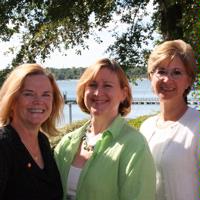VIMS: Birthplace of female presidents
Peers elect VIMS trio to top posts
Virginia is known as the birthplace of presidents, with a list that includes George, Thomas, and James. The Virginia Institute of Marine Science is now expanding that tradition with names not traditionally seen on a presidential roster: Deborah, Mary, and Linda.
During the last 5 years, VIMS professors Deborah Bronk, Mary Fabrizio, and Linda Schaffner have each been elected president of one of the three largest and most influential professional societies in the aquatic sciences.
 Fabrizio is currently serving a 1-year term as President of the American Fisheries Society (AFS). Bronk will begin her 2-year term as President of the American Society of Limnology and Oceanography (ASLO) in 2010. Schaffner served as President of the Coastal and Estuarine Research Federation (CERF) from 2003-05.
Fabrizio is currently serving a 1-year term as President of the American Fisheries Society (AFS). Bronk will begin her 2-year term as President of the American Society of Limnology and Oceanography (ASLO) in 2010. Schaffner served as President of the Coastal and Estuarine Research Federation (CERF) from 2003-05.
The trio’s achievements are particularly striking given the traditional under-representation of women in the aquatic sciences. Fabrizio is only the 7th female among 122 AFS presidents since 1870. Bronk will be the 5th female among 59 ASLO presidents since 1935. Schaffner was the 5th female among 20 CERF presidents since 1971.
VIMS Dean and Director John Wells says “This is a phenomenal achievement, and reflects extremely well on the high quality of our faculty at VIMS.”
The 9,000-member AFS is the oldest and largest association of fisheries professionals in the world. It publishes 5 highly cited scientific journals, including its Transactions and the North American Journal of Fisheries Management. ASLO, with more than 3,800 members in 58 countries, publishes Limnology and Oceanography, which the Science Citation Index rates as the most frequently cited journal in both fields (limnology is the study of inland waters, oceanography the study of the sea). CERF, with 7 affiliate societies in the U.S., Canada, and Mexico, publishes Estuaries and Coasts, the leading journal for near-shore science.
Fabrizio’s research focuses on the population dynamics of finfish. She also manages the Institute’s juvenile fish surveys, which have since 1955 played an important role in helping to manage Chesapeake Bay's fish populations. Bronk is an international expert on the role of nitrogen in aquatic ecosystems, and has developed widely used laboratory methods for tracing the movement of this nutrient through marine food webs. Schaffner is world-renowned for her studies of how natural processes and human activities affect estuarine and coastal aquatic communities, including their food webs.

